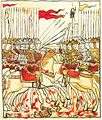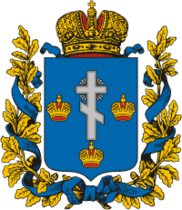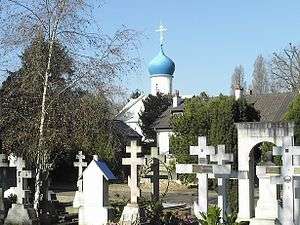Orthodox cross
.svg.png)
The Orthodox, Byzantine[1][2][3] or Russian (Orthodox) Cross,[4][5] also known as the Suppedaneum cross,[6] is a variation of the Christian cross, commonly found in the Eastern Orthodox Churches, as well as the Eastern Catholic Churches of the Byzantine Rite, and used widely by groups to connote the Byzantine Rite. The cross has three horizontal crossbeams—the top one represents the plate which in the older Greek tradition is inscribed with a phrase based on John's Gospel "The King of Glory", but in later images it represents INRI, and the bottom one, a footrest. In many depictions, the side to Christ's right is higher. This is because the footrest slants upward toward the penitent thief St. Dismas, who was (according to tradition) crucified on Jesus' right, and downward toward impenitent thief Gestas. It is also a common perception that the foot-rest points up, toward Heaven, on Christ’s right hand-side, and downward, to Hades, on Christ’s left. One of the Orthodox Church’s Friday prayers clearly explains the meaning: "In the midst, between two thieves, was Your Cross found as the balance-beam of righteousness; For while one was led down to hell by the burden of his blaspheming, the other was lightened of his sins unto the knowledge of things divine, O Christ God glory to You." Though commonly associated with the Russian Orthodox Church, this version is found also in the Greek and Serbian Orthodox churches,[7] although other varieties are also common, including those with a straight footstool and one slanted in the opposite direction. Common variations include the "Cross over Crescent" and the "Calvary cross".
Russian variations

.jpg)
One variation of the Orthodox Cross is the 'Cross over Crescent', which is sometimes accompanied by "Gabriel perched on the top of the Cross blowing his trumpet."[8] Didier Chaudet, in the academic journal China and Eurasia Forum Quarterly, writes that an "emblem of the Orthodox Church is a cross on top on a crescent. It is said that this symbol was devised by Ivan the Terrible, after the conquest of the city of Kazan, as a symbol of the victory of Christianity over Islam through his soldiers"; the Orthodox World Encyclopaedia concurs with this view.[9][10][11] However, B.A. Uspensky offers another view, stating that in pre-Christian times, the 'Cross over Crescent' symbolized the sun and the moon, and that in the Christian Era, the cross is a symbol of Christ and the moon is a symbol of the Virgin Mary.[12]
In Russia, the top crossbeam can be absent; however, in the Russian North it can be attached on top of the vertical beam.[13]
A variation is a monastic "Calvary Cross", in which the cross is situated atop the hill of Calvary, its slopes symbolized by steps. To the viewer's left is the Holy Lance, with which Jesus was wounded in his side, and to the right, a pole topped by a vinegared hyssop sponge. Under Calvary are Adam's skull and bones;[2] the right-arm bone is usually above the left one, and believers fold their arms across their chests in this way during Orthodox communion. Around the cross are abbreviations in Church Slavonic. This type of cross is usually embroidered on a schema-monk's robe.
Between 1577–1625, the Russian Orthodox Cross was depicted between the heads of a double-headed eagle in the coat of arms of Russia. It was drawn on military banners until the end of the 17th century.[14]
Gallery
_-_East_wall%2C_right_(Harrowing_of_Hell)_03.jpg) The Descent of Christ into hell, a mosaic from Hosios Loukas in Greece, the 11th century
The Descent of Christ into hell, a mosaic from Hosios Loukas in Greece, the 11th century_-_West_wall%2C_left_-_detail_03_(Constantine_and_Helena)_02.jpg) Constantine and Helena in the Exaltation of the Cross, a mosaic from Hosios Loukas in Greece, the 11th century
Constantine and Helena in the Exaltation of the Cross, a mosaic from Hosios Loukas in Greece, the 11th century- The Crucifixion, a 13th-century mosaic from Constantinople
 15th-century Russian depiction in which the traditional INRI plank is instead marked with "ЦР҃Ь СЛ҃ВЫ", standing for "King of Glory"
15th-century Russian depiction in which the traditional INRI plank is instead marked with "ЦР҃Ь СЛ҃ВЫ", standing for "King of Glory" Coat of arms of Russia from the seal of Ivan IV (the Terrible), 1577
Coat of arms of Russia from the seal of Ivan IV (the Terrible), 1577 Coat of arms of Russia from the seal of Fyodor I, 1589
Coat of arms of Russia from the seal of Fyodor I, 1589.jpg) A rider with the banner from an icon Blessed Be the Host of the King of Heaven (Church Militant), 1550s
A rider with the banner from an icon Blessed Be the Host of the King of Heaven (Church Militant), 1550s A 17th-century miniature of the Battle of Kulikovo (1380). A warrior bears a red banner with a cross
A 17th-century miniature of the Battle of Kulikovo (1380). A warrior bears a red banner with a cross A copper cross typical for Old believers
A copper cross typical for Old believers A cross of a Russian Orthodox priest
A cross of a Russian Orthodox priest A modern memorial to Ss. Cyril and Methodius in Khanty-Mansiysk, Russia
A modern memorial to Ss. Cyril and Methodius in Khanty-Mansiysk, Russia Coat of arms of Kherson Governorate, Russian Empire, 1878
Coat of arms of Kherson Governorate, Russian Empire, 1878 Sainte-Geneviève-des-Bois Russian Cemetery, the resting place of many eminent Russian émigrés.
Sainte-Geneviève-des-Bois Russian Cemetery, the resting place of many eminent Russian émigrés.
References
- ↑ Becker, Udo (2000). The Continuum encyclopedia of symbols. Continuum International Publishing Group. p. 71. ISBN 978-0-8264-1221-8.
- 1 2 McGuckin, John Anthony (2011). "Cross". In John Anthony McGuckin. The encyclopedia of Eastern Orthodox Christianity. 1. John Wiley and Sons. p. 170. ISBN 978-1-4051-8539-4.
- ↑ Ogechukwu, Nwaocha (2009). The Secret Behind the Cross and Crucifix. Strategic Book Publishing. p. 19. ISBN 978-1-60693-367-1.
- ↑ Liungman, Carl G. (2004). Symbols - Encyclopedia of Western Signs and Ideograms. Ionfox AB. p. 140. ISBN 978-91-972705-0-2.
- ↑ Thomas, Robert Murray (2007). Manitou and God: North-American Indian religions and Christian culture. Greenwood Publishing Group. pp. 121–122. ISBN 978-0-313-34779-5.
- ↑ Zielinski, Siegfried; Link, David; Wagnermaier, Silvia; Eckhard Fuerlus; Gloria Custance (2006). Variantology 2: On Deep Time Relations of Arts, Sciences and Technologies. W. König. ISBN 9783865600509. Retrieved 28 March 2014.
- ↑ Gerstel, Sharon (2006). "An Alternate View of the Late Byzantine Sanctuary Screen," in Thresholds of the Sacred: Art Historical, Archaeological, Liturgical and Theological Views on Religious Screens, East and West, ed. S. Gerstel. pp. 146–47.
- ↑ Stevens, Thomas (1891). Through Russia on a Mustang. Cassell. p. 248. Retrieved 28 March 2014.
It seemed rather rough on Tartars, too, as showing scant consideration for the religious susceptibilities of a subject people, to find some of the domes of the Orthodox churches ornamented with devices proclaiming the triumph of the Cross over the Crescent. A favorite device is a Cross towering above a Crescent, with Gabriel perched on the top of the Cross blowing his trumpet.
- ↑ Chaudet, Didier (2009). "When the Bear Confronts the Crescent: Russia and the Jihadist Issue". China and Eurasia Forum Quarterly. Central Asia-Caucasus Institute & Silk Road Studies Program. 7 (2): 37–58. ISSN 1653-4212.
It would be convenient to characterize the relationship between Russia and Islam by its history of conquest and tension. After all, the emblem of the Orthodox Church is a cross on top on a crescent. It is said that this symbol was devised by Ivan the Terrible, after the conquest of the city of Kazan, as a symbol of the victory of Christianity over Islam through his soldiers.
- ↑ "Russian Orthodox Church". Journal of South Asian and Middle Eastern Studies. 17: 4. 1993.
Finally, the Russians, under Ivan the Terrible, defeated the Tatars in 1552 and firmly established Russian rule. In celebration of this conquest, the czar built two churches in the Moscow Kremlin and on the spires of the Church installed the Orthodox Cross over an upside down crescent, the symbol of Islam.
- ↑ "Church Building and Its Services". Orthodox World. Retrieved 28 March 2014.
Sometimes the bottoms of the Crosses found on Russian churches will be adorned with a crescent. In 1486, Tsar Ivan IV (the Terrible) conquered the city of Kazan which had been under the rule of Moslem Tatars, and in remembrance of this, he decreed that from henceforth the Islamic crescent be placed at the bottom of the Crosses to signify the victory of the Cross (Christianity) over the Crescent (Islam).
- ↑ Успенский, Б. А. (2006). Крест и круг: Из истории христианской символики (in Russian). М.: Языки славянских культур. pp. 225–258.
Итак, сочетание креста и полумесяца целиком вписывается в космологическую, языческую по своему происхождению символику: крест и полумесяц символизируют солнце и луну. Вполне закономерно, что сочетание креста и полумесяца встречается на русских лунницах. 232 Но вместе с тем оба символа имеют и другой, христианский смысл: крест очевидным образом выступает как символ Христа, тогда как луна в христианской традиции символизирует Богородицу. Такое толкование прямо соответствует каноническим текстам — и поддерживается ими, — текстам, где Христос называется «Солнцем правды» или «Солнцем праведным» ( «sol justitiae» — Мал. IV,2) , а Богородица может ассоциироваться с апокалиптическим образом «жены, облеченной в солнце; под ногами ее луна, и на главе ее венец из двенадцати звезд» (Откр. ХII, 1).
- ↑ Kuznetsov 1997.
- ↑ Shpakovsky, Viacheslav; Nicolle, David; McBride, Angus (2006). "Infantry and cavalry banners". Armies of Ivan the Terrible: Russian Troops 1505-1700. Osprey Publishing. p. 23. ISBN 978-1-84176-925-7.
External links
| Wikimedia Commons has media related to Orthodox crosses. |
- "Explanation of the Three-Bar Cross". Church of the Nativity: Russian Orthodox Old Rite. Retrieved October 20, 2011.
- V. Rev. John Shandra. "The Skull on the 'Russian' Orthodox Cross". Retrieved October 20, 2011.
- Kuznetsov, V. P. [Кузнецов В. П.] (1997). History of the development of the cross's forms. Short course of Orthodox staurography. История развития формы креста. Краткий курс православной ставрографии (in Russian). Moscow. External link in
|title=(help)
